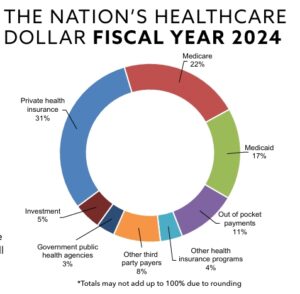Introduction
House Republicans released a budget blueprint on February 12th that directs the Energy and Commerce Committee to achieve $880 billion in savings from fiscal years 2025 through 2034. GOP Budget Reconciliation Bill Draft
Budget Overview
The budget resolution does not provide specific instructions on how the committee should achieve the $880 billion in savings. However, Medicare and Medicaid, being the largest programs under its oversight, are likely targets. The to $880 billion in savings constitute more than half of the $1.5 trillion total cost reductions that Republican lawmakers aim to achieve over the 10-year period.
As hospitals and other providers prepare for potential funding cuts, national trade associations have responded with strong opposition, arguing that disrupting Medicaid coverage would not cut healthcare costs but merely shift them, potentially weakening efforts to combat chronic disease.
LeadingAge, the trade association representing primarily non-profit senior living/post-acute care providers issued an Action Alert on various policies, including potential Medicaid cuts. The alert went out to their members the week prior to the budget resolution. Action Alert
Department of Government Efficiency (DOGE) Involvement
In early February, Elon Musk’s Department of Government Efficiency (DOGE) gained access to the Centers for Medicare & Medicaid Services (CMS) systems, which manage over $1 trillion in annual payments. DOGE had been analyzing CMS spending data for potential fraud, abuse, or waste. https://rhislop3.com/medicaid-spending-in-the-doge-radar/ CMS spent more than $1.5 trillion on health-care programs in fiscal year 2024, accounting for 22 percent of total federal spending, according to the agency’s 2024 annual report.
According to 2024 projections, Medicare and Medicaid (including state funding) represent 39 cents of every dollar spent on healthcare in the U.S.— or looked at from three different perspectives: 49 cents of every dollar spent on nursing homes, 42 cents of
every dollar received by U.S. hospitals, and 37 cents of every dollar spent on physician services. The federal government is the largest consumer/purchaser of healthcare services in the U.S.

Potential Impact on Healthcare Programs
The Trump administration has stated that it will not cut Medicare, but Medicaid and Affordable Care Act (ACA) subsidies remain at risk. It is challenging to envision how the committee could meet its significant cost-cutting target without making substantial cuts to federal healthcare programs.
Without Congressional action, the Trump administration can make significant programmatic changes through administrative actions (including state demonstration waivers, regulations, and other guidance). Medicaid is the primary program providing comprehensive health and long-term care to one in five people living in the U.S. In terms of Medicaid, a plausible outline of spending reductions is below.
Federal funding cuts
- Imposing a per capita cap on federal Medicaid spending
- Reducing the federal government’s share of costs for the Affordable Care Act (ACA) expansion group
- Reducing the minimum federal matching rate for Medicaid expenditures
Work requirements
- Imposing work requirements to receive Medicaid coverage
- Locking people out of coverage for up to a year if they seek Medicaid after disenrolling from other forms of health coverage
- Limiting Medicaid coverage to people who meet certain work requirements
Weakened benefits
- Eliminating benefits that exceed those provided in the private market
- Exposing Medicaid enrollees to higher-cost private coverage
Other proposals
- Converting Medicaid to a block grant
- Altering the federal matching percentage (FMAP)
- Restricting or eliminating the use of provider taxes
Overall Spending Reduction Goals
The House budget resolution calls for a reduction in mandatory spending of $2 trillion over a decade. A significant portion of this reduction could come from cuts to Medicaid. Earlier this year, I wrote a post regarding healthcare spending and the opportunities that may be present for reform/savings https://rhislop3.com/fixing-healthcare-spending-in-the-u-s/
One of the conditions to watch going forward is state budgets. Medicaid is funded via federal government matching dollars to state budget allocations. Economic changes or for example, recession, could significantly change state budget fortunes and in turn, the ability to fund continuing programs such as Home and Community Based Services (HCBS).
What is certain is that the goal of saving $880 billion in health spending is fraught with undesirable choices. As I have written before and talked about for decades, the challenge is less around saving and more around programmatic overhaul. Medicare and Medicaid are programs that have morphed beyond their original intention and in turn, developed benefits and funding challenges, well beyond current sustainability. Both programs are riddled with waste, fraud and abuse, with estimates running north of $100 billion. Granted, $100 billion does not equate to $880 billion but starting here and then working on program relevancy (both programs need modernization of administration, benefits and coverages) and sustainable funding mechanisms would be a great start.